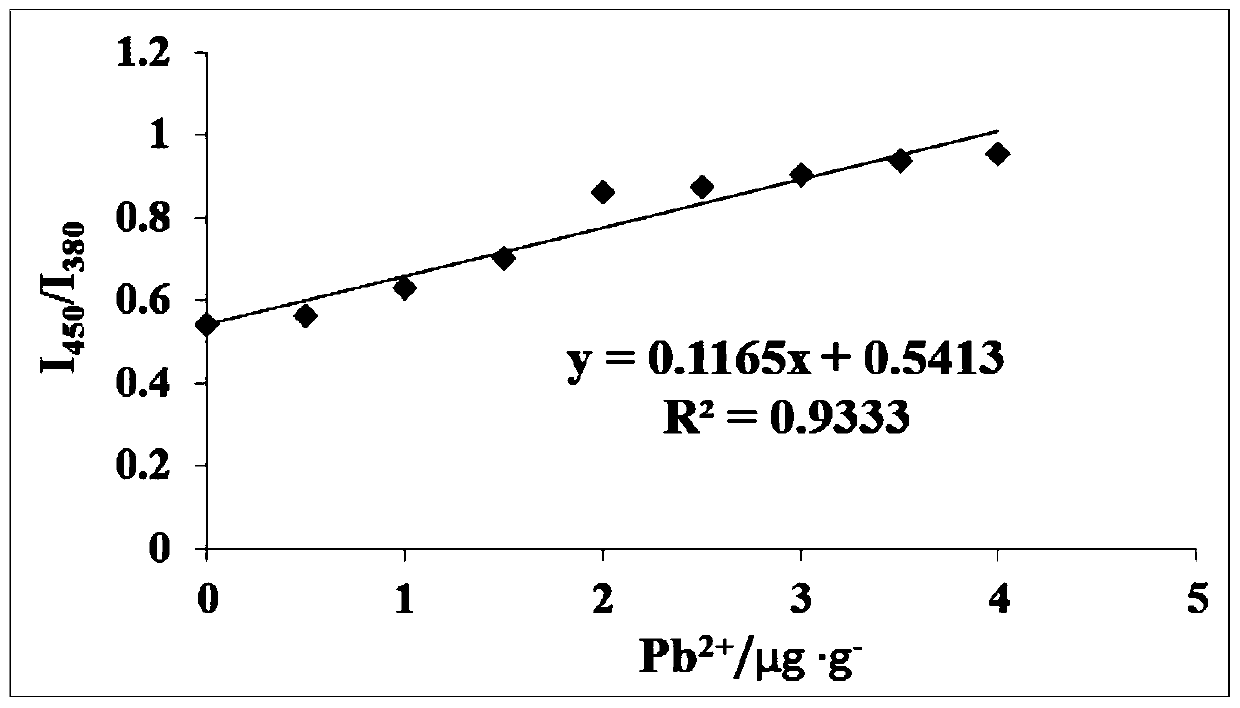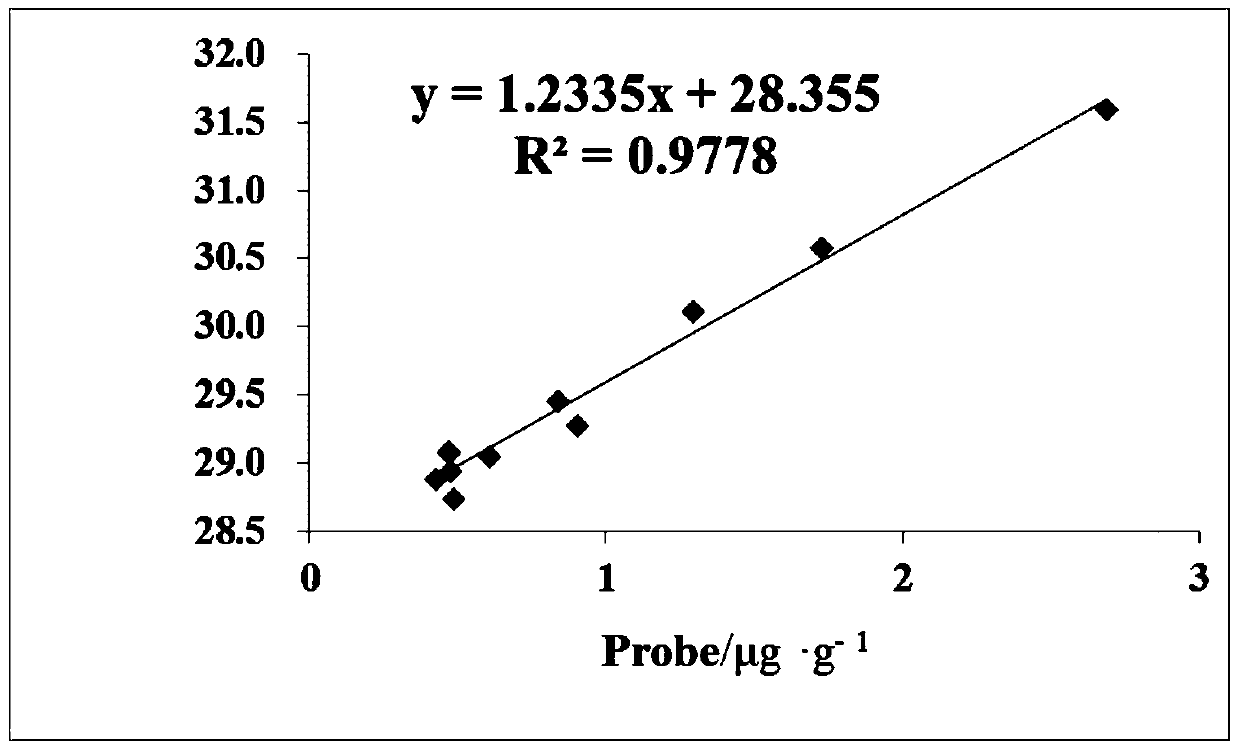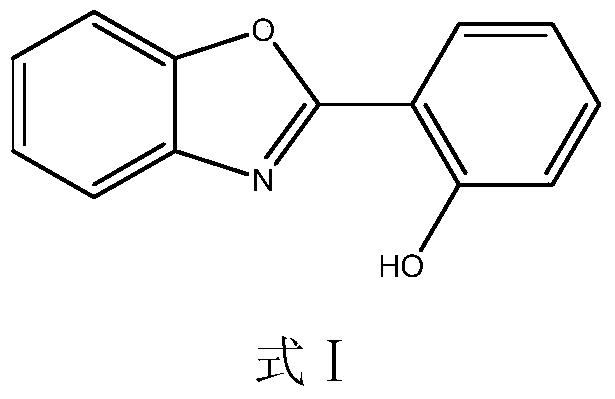A kind of method for detecting total heavy metal content in medicinal materials
A technology for heavy metals and medicinal materials, applied in material excitation analysis, fluorescence/phosphorescence, etc., can solve the problem of inability to quantitatively measure total heavy metals, and achieve the effects of sensitive response, accurate total heavy metal content, and short use time
- Summary
- Abstract
- Description
- Claims
- Application Information
AI Technical Summary
Problems solved by technology
Method used
Image
Examples
Embodiment 1
[0050] Embodiment 1, the establishment of the mathematical model of total heavy metal content detection in medicinal materials
[0051] 1. Solution preparation
[0052] Preparation of fluorescent probe solution: Accurately weigh 0.380 g of fluorescent probe crystal to dissolve it completely in acetonitrile, place it in a 1L volumetric flask, then add acetonitrile to constant volume to obtain a fluorescent probe solution with a concentration of 1.8 mM, and place it in a UV The fluorescent probe solution exhibits green fluorescence under light. Store in the dark at 4°C for later use.
[0053] Preparation of HEPES buffer solution: Accurately weigh 11.915g of HEPES powder, add 40ml of pure water to dissolve it, adjust the pH value to 7.0, and adjust the volume of pure water to 50ml to obtain a HEPES buffer solution with a concentration of 1.0M. Store at 4°C for later use .
[0054]Preparation of lead nitrate solution: Weigh different lead nitrate standard products and dissolve ...
Embodiment 2
[0064] Embodiment 2, the detection of total heavy metal content in Akebia
[0065] 1. Solution preparation
[0066] Probe solution preparation: Precisely weigh 0.380 g of the probe crystal to be completely dissolved in acetonitrile, place it in a 1L volumetric flask, and then add acetonitrile to constant volume to obtain a fluorescent probe solution with a concentration of 1.8 mM. The fluorescent probe solution showed green fluorescence. Store in the dark at 4°C for later use.
[0067] Preparation of HEPES buffer solution: Accurately weigh 11.915g of HEPES powder, add 40ml of pure water to dissolve it, adjust the pH to 7.0, and adjust the volume of pure water to 50ml to obtain a HEPES buffer solution with a concentration of 1.0M. Store at 4°C for later use.
[0068] Preparation of Akebia test solution: Weigh 0.5g of Akebia powder sample, add 50ml of acetonitrile solution to dissolve it, sonicate for 1min and centrifuge to take the supernatant for later use.
[0069] 2. Dete...
Embodiment 3
[0075] Embodiment 3, the detection of total heavy metal content in Magnolia officinalis
[0076] 1. Solution preparation
[0077] Probe solution preparation: Precisely weigh 0.380 g of the probe crystal to be completely dissolved in acetonitrile, place it in a 1L volumetric flask, and then add acetonitrile to constant volume to obtain a fluorescent probe solution with a concentration of 1.8 mM. The fluorescent probe solution showed green fluorescence. Store in the dark at 4°C for later use.
[0078] Preparation of HEPES buffer solution: Accurately weigh 11.915g of HEPES powder, add 40ml of pure water to dissolve it, adjust the pH to 7.0, and adjust the volume of pure water to 50ml to obtain a HEPES buffer solution with a concentration of 1.0M. Store at 4°C for later use.
[0079] Preparation of magnolia bark test solution: Weigh 0.5g magnolia bark powder sample, add 50ml acetonitrile solution to dissolve it, ultrasonicate for 1min, and centrifuge to take the supernatant for ...
PUM
| Property | Measurement | Unit |
|---|---|---|
| concentration gradient | aaaaa | aaaaa |
Abstract
Description
Claims
Application Information
 Login to View More
Login to View More - R&D
- Intellectual Property
- Life Sciences
- Materials
- Tech Scout
- Unparalleled Data Quality
- Higher Quality Content
- 60% Fewer Hallucinations
Browse by: Latest US Patents, China's latest patents, Technical Efficacy Thesaurus, Application Domain, Technology Topic, Popular Technical Reports.
© 2025 PatSnap. All rights reserved.Legal|Privacy policy|Modern Slavery Act Transparency Statement|Sitemap|About US| Contact US: help@patsnap.com



